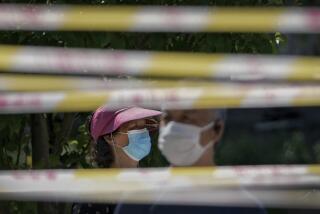Bird Flu Has Struck 3 More Areas, China Says
- Share via
BEIJING — Three more areas in China reported avian flu cases Friday, raising concerns that the world’s second-largest poultry producer was on the verge of a major outbreak. New cases make it imperative that China, the world’s most populous nation, quickly assess the scope of the disease within its borders and the tools available to contain it, the World Health Organization said.
The official New China News Agency reported new avian flu cases affecting bird populations in the eastern province of Anhui, the city of Shanghai and the southern province of Guangdong besides those already seen in Guangxi, Hubei and Hunan provinces. In response, Hong Kong announced a ban on all live birds and any chicken or duck meat from the mainland.
The WHO said the disease’s spread in Vietnam, Indonesia and elsewhere had revealed weaknesses in the global surveillance system. Given China’s huge size and many impoverished areas, there’s no room for complacency or delay, said Beijing-based WHO official Roy Wadia. “We’re racing against time,” he said.
It’s important to assess how well provincial governments are able to identify potential infections in fowl and humans, Wadia said, especially in poor areas such as Guangxi, where public health resources are limited. The local governments have to ensure that local outbreaks are identified and reported to higher authorities, and that any infected people are isolated and treated and their recent contacts tracked.
Avian influenza has killed 10 people in Vietnam and Thailand in recent weeks; the most deadly strain of the virus has been identified as H5N1.
So far, humans have contracted the illness only through direct contact with infected birds and their waste byproducts, and no human cases have been found in China. But health experts have expressed concern that the disease could become transmissible between humans if the virus mutated.
An article in the current issue of British weekly New Scientist suggested that China was the source of the outbreak, adding that a decision by China to vaccinate chickens rather than kill them outright in 1997 -- the year an avian flu outbreak in Hong Kong devastated the territory’s poultry flocks -- might have added to the problem by masking the symptoms.
The article drew a strong denunciation Thursday from Chinese Foreign Ministry spokeswoman Zhang Qiyue, who said it is “completely inaccurate, is without proof and moreover does not respect science.”
Wadia said the WHO was concerned about China’s vaccination program and was seeking more information. But he said the article was rather provocative and didn’t appear to include much corroboration, particularly for the charge that China was the source of the outbreak.
The spread of avian flu across Asia is raising alarms, considering that it comes on the heels of the severe acute respiratory syndrome, or SARS, outbreak last winter, which killed 800 people worldwide and sickened thousands before it was contained. A few new SARS cases -- none of which were fatal -- have been reported recently in China, Singapore and Taiwan.
China now has a fairly strong surveillance network in place for the SARS virus, Wadia said; the avian flu, however, presents different challenges. In theory, though, some surveillance systems could be adapted to keep track of the new threat.
In China, fighting SARS mainly involved the Ministry of Health and the WHO. The avian flu requires a wider battle, and with the Farm Ministry and the United Nations’ Food and Agriculture Organization also playing a role, opportunities for miscommunication have arisen.
In addition, the avian flu outbreak has different economic ramifications from those posed by SARS. Impoverished Chinese farmers often are reluctant to kill their chickens, particularly if the birds appear healthy, on what they see as the slim chance that the fowl was infected by a farm miles away. The potential for evasion and the smuggling of poultry out of infected areas are added risks, officials said.
Deng Hongkui, an expert at the life sciences college of Beijing University, said it is essential that Chinese provinces report cases quickly to stem the spread. But the Chinese leadership seems well aware of the potential danger of avian flu, he said, given its experience with SARS -- the nation came under severe domestic and global criticism for concealing the outbreak.
Unlike SARS, which primarily struck large urban areas, bird flu is likely to be more prevalent in China’s vast and often impoverished countryside, where regulation, education and communications are often much weaker, Deng said.
So far, only a few hundred thousand birds have been killed in China, compared with millions across the rest of Asia. Thailand has slaughtered 10.7 million chickens, many of them buried alive in deep pits.
More to Read
Sign up for Essential California
The most important California stories and recommendations in your inbox every morning.
You may occasionally receive promotional content from the Los Angeles Times.













